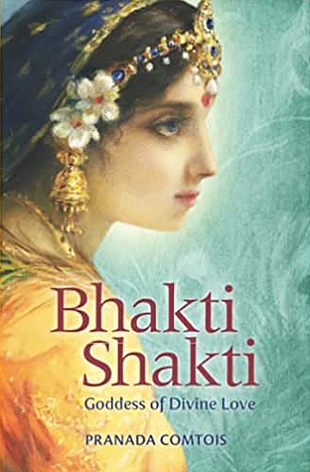This slim book proves an excellent introduction to the school of bhakti, which in native religious practices of India, usually called Hinduism, focuses on practices of love and devotion in relationship with personal aspects of what we call God. The Hindu scriptures Bhagavad Gita and Bhagavata Purana are its primary sources. In Sanskrit, the word bhakti means simply, “participation” or “attachment.”
A shakti — the other word in the book’s title — is a kind of sacred energy. The book’s introduction offers this promise to the reader: “We’ll uncover a confidential shakti hidden deep within the Upanishads and Puranas known as bhakti-shakti, the energy of divine love.”
Pranada Comtois explains it this way: “Bhakti is neither ordinary devotion nor ordinary service. Love, devotion, and service are purified and become bhakti when our love is unselfish, unmotivated, and constant, and we repose it in the perfect object of love.”
Why does someone need God or the Divine to experience and express this kind of love? Comtois answers, “I learned that to remain whole, I have to fill myself up from an infallible source because no human love can fulfill me. In fact, no human love can completely fill anyone.”
The author then asks readers not to treat the Divine as simply a metaphor, but as a living person. There are several options for this, including relating to Durga and Radha, two of the most popular deities in the Hindu pantheon. Comtois explains, referring to Durga: “If we don’t trivialize her or simply take from her but instead approach her with a devotion free from selfish motives, she’ll reciprocate our affection and allow us to see the self.” This reference to seeing the self means, to understand ourselves and God, because they are one.
Chapter 10 looks at “Durga Devi: Goddess of the Material Nature,” because all of this focus on love doesn’t mean that bhakti practitioners believe that bad things don’t happen. “There is evil in the world,” Comtois writes,“ and the caretaker of creation rides forward on the back of a ferocious lion to check its influence. Durga swings her bloody sword in one of her ten hands and flings a demon’s head away from her with another.” Ways of worshiping Durga follow, as well as advice on how to relate to her as a divine mother.
Comtois wants to see a “return of the age of the goddess.” She also teaches that each human soul is essentially female, adding, “In this light, the phrase divine feminine takes on new meaning. When we use the phrase divine feminine to refer to the self instead of feminine qualities in both women and men then we use the phrase correctly.”
The book culminates in its look at Sri Radha, another deity that is traditionally gendered female, and her relationship with Krishna. Comtois explains how her own life has been transformed by devotion to Radha. “It’s through my bhakti practice that I’ve fallen in love with Sri Radha, who has come alive in a most profound way…. Radha generously invests me with the energy of divine love. Thus filled, I’m more able to give unconditional love and actively express compassion by helping others.”
